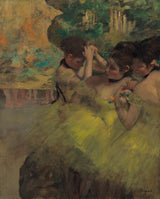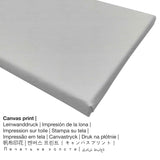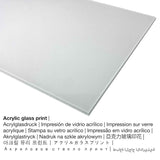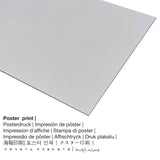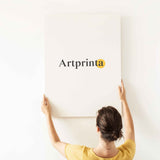Hilaire Germain Edgar Degas, 1876 - Ndị na-agba odo odo (Na Wings) - mbipụta nka mara mma.
Ụtụ gụnyere. Mbupu gbakọrọ na ndenye ọpụpụ.
Nke a kariri 140 ihe nka afọ afọ aha ya Yellow Dancers (In the Wings) e sere ya nwoke onye na-ese ihe Hilaire Germain Edgar Degas n'afọ 1876. Nke mbụ nwere nha ndị a: 73,5 × 59,5 cm (28 15/16 × 23 7/16 na). Oil on canvas was applied by the European artist as the medium of the painting. The original artwork is inscribed with the following information - inscribed at lower right: Degas. What is more, this work of art can be viewed in in the Art Institute Chicago's digital art collection. With courtesy of: Art Institute Chicago (ikike - ngalaba ọha). The creditline of the artwork is the following: Gift of Mr. and Mrs. Gordon Palmer, Mrs. Bertha P. Thorne, Mr. and Mrs. Arthur M. Wood, and Mrs. Rose M. Palmer. What is more, the alignment is Eserese na oke nke 1: 1.2, nke pụtara na ogologo bụ 20% mkpụmkpụ karịa obosara.
Họrọ ngwa ngwaahịa gị
Nchịkọta ndetu ngwaahịa na-enye gị ohere ịhọrọ nha na ihe onwunwe dịka mmasị gị si dị. Ị nwere ike ịhọrọ n'ime nhọrọ nhazi ngwaahịa ndị a:
- Mbipụta enyo acrylic: The acrylic glass print, often denoted as a plexiglass print, will turn your favorite original into brilliant home decoration. The great advantage of a plexiglass fine art copy is that sharp contrasts plus granular painting details become exposed with the help of the fine tonal gradation. Our real glass coating protects your chosen fine art print against sunlight and external influences for several decades.
- Mbipụta nke aluminom: This is a metal print manufactured on aluminium dibond with an outstanding depth, which makes a fashionable look throuch a non-reflective surface structure.
- Mbipụta kwaaji: The canvas print, not to be mistaken with a real painting on a canvas, is a digital copy applied onto canvas. A printed canvas of your favorite masterpiece will allow you to transform your into a large collection piece as you know from galleries. Hanging your canvas print: Canvas prints are relatively low in weight, which implies that it is easy to hang up your Canvas print without the support of any wall-mounts. Because of thatcanvas prints are suitable for any kind of wall.
- Bipụta akwụkwọ mmado n'ihe kwaaji: Our poster print is a printed canvas paper with a slightly roughened surface finish. It is perfectly designed for framing your art copy with a custom frame. Please note, that depending on the size of the poster print we add a white margin of around 2-6cm around the print to facilitate the framing.
Disclaimer: We try to depict our art products as accurately as possible and to showcase them visually in our shop. Nonetheless, the colors of the print products, as well as the imprint can vary to a certain extent from the image on your device's screen. Depending on your settings of your screen and the condition of the surface, not all colors are printed as realisitcally as the digital version. Because the art reproductions are processed and printed by hand, there might as well be minor deviations in the size and exact position of the motif.
Ngwaahịa a
| Ụdị ngwaahịa: | ọrụ mgbidi |
| Mmeputakwa: | mmeputakwa n'ụdị dijitalụ |
| Production usoro: | mbipụta dijitalụ |
| Nlụpụta: | arụpụtara na Germany |
| Ụdị ngwaahịa: | mmepụta ihe na-achọ |
| Eji ngwaahịa emebere: | foto mgbidi, ụlọ ihe osise nka |
| Ndozi onyonyo: | usoro eserese |
| Oke akụkụ onyonyo: | 1: 1.2 ogologo ruo obosara |
| Ntụgharị asụsụ oke onyonyo: | ogologo bụ 20% mkpụmkpụ karịa obosara |
| Nhọrọ akwa: | ígwè ebipụta (aluminium dibond), acrylic glass print (nwere ezigbo mkpuchi iko), mbipụta akwụkwọ mmado (akwụkwọ kwaaji), akwụkwọ akwa akwa. |
| Nhọrọ nke Canvas Mbipụta (akwa akwa na etiti ihe ndọtị): | 50x60cm - 20x24", 100x120cm - 39x47", 150x180cm - 59x71" |
| Mpempe iko acrylic (nwere ezigbo mkpuchi iko) nha dị iche iche: | 50x60cm - 20x24", 100x120cm - 39x47", 150x180cm - 59x71" |
| Mbipụta akwụkwọ mmado (akwụkwọ kwaaji): | 50x60cm - 20x24", 100x120cm - 39x47" |
| Mbipụta nke aluminom (ihe aluminom): | 50x60cm - 20x24", 100x120cm - 39x47" |
| Nhazi nke nka nka: | na-enweghị etiti |
Data ndabere gbasara ọrụ nka mbụ
| Aha nka: | "Yellow Dancers (In the Wings)" |
| Nhazi nka nka: | sere |
| Otu izugbe: | nkà nke oge a |
| oge: | 19th narị afọ |
| Afọ nka: | 1876 |
| Afọ nka: | 140 afọ |
| Usoro izizi: | mmanụ na kwaaji |
| Nha nke ihe osise izizi: | 73,5 × 59,5 cm (28 15/16 × 23 7/16 na) |
| Akara mbinye aka: | inscribed at lower right: Degas |
| Egosiputara na: | Ụlọ ọrụ Art Chicago |
| Ebe ebe ngosi nka: | Chicago, Illinois, Njikota Obodo Amerika |
| Ebe nrụọrụ weebụ ihe ngosi nka: | Ụlọ ọrụ Art Chicago |
| Ụdị ikike nka: | ngalaba ọha |
| Site n'aka: | Ụlọ ọrụ Art Chicago |
| Ebe kredit nke ọrụ nka: | Gift of Mr. and Mrs. Gordon Palmer, Mrs. Bertha P. Thorne, Mr. and Mrs. Arthur M. Wood, and Mrs. Rose M. Palmer |
Banyere onye na-ese ihe
| Ihe nkiri: | Hilaire Germain Edgar Degas |
| Gender: | nwoke |
| Obodo onye nka: | French |
| Ọrụ nke onye na-ese ihe: | onye na-ese ihe |
| Obodo onye nka: | France |
| nhazi ọkwa: | omenkà nke oge a |
| Oge ndu: | 83 afọ |
| Amụrụ n'afọ: | 1834 |
| Afọ nwụrụ: | 1917 |
© Nwebiisinka nke - www.artprinta.com (Artprinta)
Nkọwa ndị ọzọ dị ka ihe ngosi nka nyere (© - Art Institute Chicago - Ụlọ ọrụ Art Chicago)
Edgar Degas first painted dancers as an independent subject in 1871. He was to devote almost half his output as an artist to this subject, observing countless performances and rehearsals at the Paris Opéra. Here he placed the viewer in the wings, as if among the elite Opéra subscribers who roamed and socialized backstage. Dance subjects allowed Degas to contemporize his lifelong interest in showing the human body in complex movement, shifting the scene from ancient history to modern Paris. He finished and signed the present canvas in time for the second Impressionist exhibition, in April 1876.

